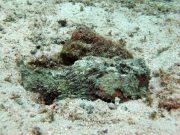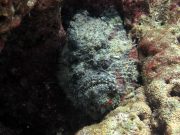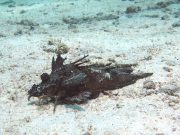Tauchen mit Steinfische
Meeresleben von Lanta | Synanceiidae
Die Steinfischfamilie Synanceiidae sind langsam schwimmende, am Meeresboden lebende Fische, die in flacheren Bereichen des Riffs zwischen Felsen und Korallen leben. Auf unseren Tauchausflügen nach Koh Lanta finden wir Steinfische am ehesten in der Lagune von Koh Haa.
Die Mitglieder dieser Familie sind meist stämmige Fische mit großen Köpfen und Mäulern und kleinen Augen. Der Körper ist mit warzenartigen Hautdrüsen und fleischigen Lappen bedeckt, die zur Tarnung beitragen können. Manchmal wachsen Algen auf dem Körper, was die Tarnung zusätzlich verbessert.
Steinfische liegen normalerweise auf dem Meeresgrund, sind im Sand vergraben oder klammern sich an ein Stück totes Korallenriff. Sie sind Meister der Tarnung, da sie sich als Felsen und Steine tarnen und sich in Farbe und Form fast vollständig ihrer Umgebung anpassen.



Ähnlich wie ihre Verwandten, die Skorpionfische, haben Steinfische sehr scharfe, hohle Rückenflossenstacheln, die einer Injektionsnadel ähneln und an deren Basis sich jeweils eine Giftdrüse befindet.
Das Gift des Steinfisches dient der Selbstverteidigung und wird in der Regel injiziert, wenn ein ahnungsloses Opfer versehentlich auf einen dieser Fische tritt oder sich darauf stützt. Das neurotoxische Gift verursacht extrem starke Schmerzen.
Der graubraune, rötliche Steinfisch (Synanceia verrucosa) ist der giftigste bekannte Fisch und kommt an einigen Tauchplätzen rund um Koh Lanta vor, insbesondere in und um die Koh Haa Lagune. Das Gift des Steinfisches ist für Menschen tödlich.
Der dunkel gefärbte Indische Ozean-Walkman (Inimicus didactylus) kommt ebenfalls in und um die Koh Haa-Lagune vor und ist schwieriger zu entdecken als der Riff-Steinfisch. Normalerweise gräbt er sich tief in den Sand ein, doch selten kann man ihn beobachten, wenn er auf der Suche nach einem neuen Standort über den Meeresboden wandert.
Walkmane aus dem Indischen Ozean sind auch unter den Namen Ghoulfisch, Koboldfisch, Seekobold, Stachelteufelfisch und Stachelfisch bekannt und ebenfalls gefährlich giftig.
Wir raten davon ab, sich auf den empfindlichen Meeresböden rund um Korallenriffe hinzusetzen, hinzuknien, darauf zu laufen oder sich darauf auszuruhen, nicht nur wegen der vielen kleinen und empfindlichen Lebewesen, die auf dem Meeresgrund leben, sondern auch wegen der sehr realen Gefahr, von einem der giftigsten Fische der Natur gestochen zu werden.
Steinfische sind in der Regel Einzelgänger und ernähren sich von kleinen Fischen und Krebstieren.
2 Arten auf dieser Seite gefunden:
Reef Stonefish
(Synanceia verrucosa)
The Reef Stonefish, Synanceia verrucosa, is one of 36 members of the Synanceiidae family and is one of the most venomous fish in the world. This fish has a large head and tapering body, with its mouth on top of the face, and a deep depression between its eyes.

Synanceia verrucosa @ Koh Haa
Typically the Reef Stonefish reaches lengths of up to 30 - 40 centimeters and is generally grey or brown in colour, though it may also have small areas of yellow, red or orange.
The key difference between males and females is the size. The female stonefish is larger and broader around the abdomen than the male and can weigh as much as 50% more.
A carnivorous fish, the Reef Stonefish may settle around rocks and plants, or rest on the seabed and is extremely well camouflaged as rock or coral. They are difficult to find and are also known to use their large pectoral fins to bury themselves in the sand, with only the eyes and mouth visible.
The Reef Stonefish eats mostly small fish, shrimp, and other crustaceans. It usually waits for its prey to swim past, and then strikes with incredible speed. Waiting for hours at a time, stonefish strike when their potential prey is less than their body length away. Their powerful jaws and large, rapidly expanding mouths create so much pressure that they are easily able to suck down their unsuspecting prey and swallow it whole. The attack can last as little as 0.01 seconds and requires high-speed video equipment to capture.

Reef Stonefish @ Koh Haa
As a purely defensive measure, the dorsal fin comprises 13 sharp, stiff, hollow spines, each with a venom sac. When disturbed, the Reef Stonefish will typically not swim away, and will instead erect it's poisonous dorsal fin spines.
The venom is usually released when pressure is applied to the stonefish's spine, which means the poison is most often emitted when the stonefish is being attacked by a predator or stepped on by a human. Effects of the venom include severe pain, shock, paralysis and tissue death. A large dose can be fatal to humans. Predators of the Reef Stonefish include sharks and rays.

Reef Stonefish @ Koh Haa
The stonefish can survive out of water for up to 24 hours. This may be an adaptation to its shallow water existence where it may get trapped in drying out rock-pools during low tide.
In addition to the dorsal spines and venom, stonefish also possess a 'lachrymal sabre', a very sharp spine embedded in each side of the face, beneath each eye. This sharp blade can be deployed by squeezing its cheeks, which pull on the upper jaw and rotate the spines. This built-in weapon is non-venomous, however, they are extremely sharp.
The stonefish is a solitary animal. The only time it will actively seek out another is during mating season. The female stonefish releases a layer of eggs on the seafloor, with the male then releasing sperm over them.
Indian Ocean Walkman
(Inimicus didactylus)
The Indian Ocean Walkman, also known as the Spiny Devilfish, has a flattened head, large bulbous eyes and an upturned shout. The dorsal spines are highly venomous, with the first three being connected by a thin membrane. Dorsal spines may cause very painful and deep wounds, and can be fatal.

Inimicus didactylus @ Koh Haa
The Indian Ocean Walkman can quickly change colour to aid camouflage, and likes to partially bury itself in sand during the day. The fan-like pectoral fins are very colourful when opened, usually when disturbed or during courtship.

Inimicus didactylus @ Koh Haa
This species can sometimes be seen 'walking' on the seafloor using the forward pelvic fin spines which are not connected via fin membrane, and have adapted as forward 'legs'.

Inimicus didactylus @ Koh Haa
The Indian Ocean Walkman grows to 25 cm and is found in sand and rubble areas close to coral reefs. The diet includes small fishes and crustaceans.
Tauchen mit Steinfische rund um Koh Lanta
Tauch- und Schnorchelausflüge
Wenn Sie gerne die Gelegenheit hätten, Steinfische auf einem unserer täglichen Tauchausflüge während der Hochsaison von Koh Lanta aus zu sehen, dann senden Sie uns eine E-Mail an info@diveandrelax.com.
Nehmen Sie an unseren Speedboot-Tauchausflügen in der Hochsaison zu einigen der besten Tauchplätze Thailands teil und genießen Sie kleine Gruppen, kurze Fahrzeiten und einen Fokus auf hervorragenden persönlichen Service, Sicherheit und Spaß.
Noch kein zertifizierter Taucher? Lernen Sie auf Koh Lanta das Tauchen mit dem 3-tägigen SSI Open Water Diver Kurs.
Buchen Sie online und sparen Sie 10% auf Tauchausflüge und Tauchkurse auf Koh Lanta.
Weitere Informationen
Indo-Pazifische Meereslebewesen-Führer
- Allen, G., Steene, R., Humann, P., DeLoach, N. (2003) Reef Fish Identification, Tropical Pacific. Jacksonville, FL., USA: New World Publications, Inc., ISBN 1-878348-36-1.
- Humann, P., DeLoach, N., (2010) Reef Creature Identification, Tropical Pacific. Jacksonville, FL., USA: New World Publications Inc., ISBN 978-1-878348-44-9
- Debelius, H. (2013) Indian Ocean Reef Guide. Frankfurt, Germany: IKAN - Unterwasserarchiv, ISBN 978-3-939767-52-7.
- Debelius, H. (2004) Nudibranchs and Sea Snails, Indo-Pacific Field Guide. Frankfurt, Germany: IKAN - Unterwasserarchiv, ISBN 3-925919-51-1
- Erhardt, H., Knop, D. (2015) Corals Indo-Pacific Field Guide. Frankfurt, Germany: IKAN - Unterwasserarchiv, ISBN 3-925919-69-4.
- Veron J.E.N., Stafford-Smith M.G., Turak E. and DeVantier L.M. (2016). Corals of the World
Weitere Referenzen zu Meereslebewesen und weitere Informationen



